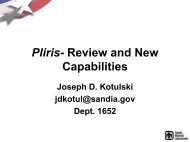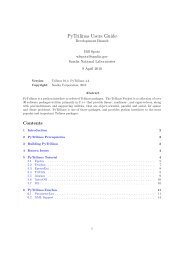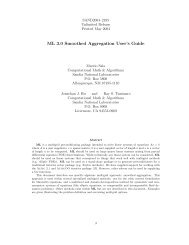nonsymmetric dynamics
ML 5.0 Smoothed Aggregation User's Guide - Trilinos - Sandia ...
ML 5.0 Smoothed Aggregation User's Guide - Trilinos - Sandia ...
- No tags were found...
You also want an ePaper? Increase the reach of your titles
YUMPU automatically turns print PDFs into web optimized ePapers that Google loves.
#16....n=5, omega=5.00e-01...........7.........1.77309e-06....0.0881529......N<br />
#17....n=5, omega=7.50e-01...........6.........8.53488e-06....0.0846661......N<br />
#18....n=5, omega=1.00e+00...........6.........2.66381e-06....0.0839909......N<br />
#19....n=5, omega=1.25e+00...........6.........4.87356e-06....0.083786.......N<br />
- Aztec preconditioner<br />
#20....ILU(fill=0)...................7.........4.93736e-06....0.0712331......N<br />
#21....ILU(fill=1)...................6.........3.54992e-06....0.0647091......N<br />
#22....ILU(fill=2)...................7.........1.4724e-06.....0.0678911......N<br />
- Aztec as solver<br />
#23....iterations=1..................7.........1.94081e-06....0.140772.......N<br />
#24....iterations=3..................4.........8.90029e-08....0.0687031......N<br />
#25....iterations=5..................3.........1.00778e-07....0.069193.......N<br />
- ParaSails<br />
#26....default.......................20........6.60045e-06....0.214094.......N<br />
*** The best iteration count was obtain in test 25<br />
*** The best CPU-time was obtain in test 21<br />
*** Total time = 2.43798(s)<br />
------------------------------------------------------------------------------<br />
6.7 Visualization Capabilities<br />
6.7.1 Visualizing the Aggregates<br />
ML offers the possibility to visualize the aggregates for all levels. Aggregates generated by<br />
Uncoupled and METIS aggregation schemes can be visualized for serial and parallel runs,<br />
while aggregates generated using MIS and ParMETIS can be visualized only for serial runs.<br />
Data can be stored in the “xyz” format, readable by packages such as XD3D [?]. For each<br />
aggregate, the file contains a line of type<br />
x-coord y-coord aggregate-number<br />
(z-coord is present only for 3D computations.) XD3D can be used to visualize files in this<br />
format, but only for 2D problems. Results are reported in Figure 2.<br />
Data can also be stored in the “vtk legacy” format, readable by packages such as ParaView<br />
[?]. ParaView allows for 2D and 3D point clouds visualization. It is also possible<br />
to visualize sections of 3D data via cutting planes. In order to use this format, fine level<br />
coordinates must be supplied. Coarse level coordinates are derived from the fine level coordinates<br />
via the multigrid restriction operators. Data is stored as follows. The first section<br />
begins with the header<br />
POINTS XX float<br />
where XX is the total number of points. For each point, the coordinates are given as<br />
40







